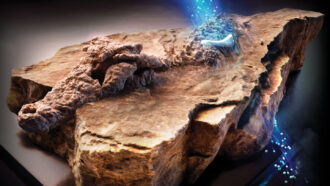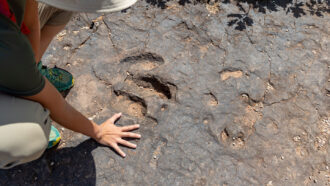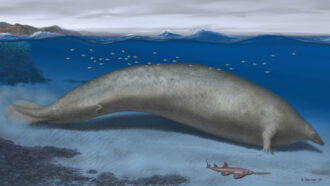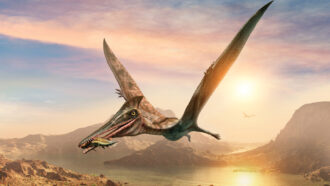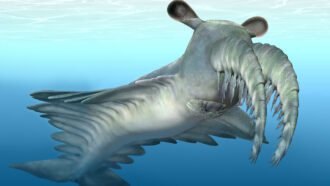A big, weird dino
A newly discovered genus of feathered dinosaurs was surprisingly huge and heavy for its shape.
By Emily Sohn
A new dinosaur find has forced scientists to rethink their understanding of these ancient creatures.
The feathered dino, which belongs to a new genus called Gigantoraptor, was surprisingly huge and heavy for its shape. It belonged to a group of birdlike dinosaurs called oviraptors. The largest animals in this group weighed no more than 40 kilograms (88 pounds).
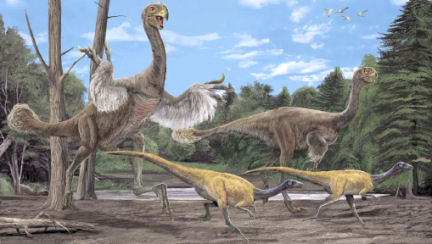 |
|
In this illustration, two Gigantoraptors tower over other small, feathered dinosaurs.
|
| Z. Chuang and X. Lida/IVPP |
Gigantoraptor, by comparison, weighed about 1.4 metric tons (more than 3,000 pounds). It was 8 meters (26 feet) long and 3.5 meters (11.5 feet) tall at its shoulder. It lived in what is now northern China, where scientists from the Institute of Vertebrate Paleontology and Paleoanthropology in Beijing found most of its leg and tail bones. The team also found part of its lower jaw and spine.
The scientists dug up the first of the creature’s bones in April 2005. The huge size of the fossils threw them off. “We first thought it might be from a sauropod,” says researcher Xing Xu. Sauropods were enormous, long-necked dinosaurs known to have lived in the region around 70 million years ago. “Then, we thought it might be from a tyrannosaur,” like Tyrannosaurus Rex, Xu adds.
As they discovered more fossils however, the scientists realized that they were looking at a new species. Based on the number of growth rings in the animal’s bones and the distances between those rings, the researchers estimate that the Gigantoraptor was about 11 years old when it died. Other evidence suggests that the giant was a young adult, but still growing.
Gigantoraptors, it appears, grew more quickly and reached adulthood earlier than the huge tyrannosaurs did, says Thomas R. Holtz Jr., a vertebrate paleontologist at the University of Maryland at College Park. Growing quickly, he says, would have helped protect the newly discovered species from attacks by hungry tyrannosaurs.
The sizes and proportions of the newly discovered dino’s leg bones suggest that the animal was a speedy runner. It “would have been among the fastest dinosaurs of its body size,” Holtz speculates.
Many oviraptors had feathers, and because Gigantoraptor looked like these smaller, birdlike animals, Xu suspects it had feathers too. That’s a perplexing thought. Within the family of dinosaurs that produced birds, animals with larger bodies usually looked less like birds than smaller members of the group did. The bigger animals tended to have smaller limbs relative to their bodies, and their lower-leg bones were shorter in proportion to their upper legs.
“It’s really a surprising discovery,” says Xu. Adds Holtz, “This is one weird dinosaur.”—Emily Sohn
Going Deeper:
Perkins, Sid. 2007. Big and birdlike: Chinese dinosaur was 3.5 meters tall. Science News 171(June 16):371. Available at http://www.sciencenews.org/articles/20070616/fob1.asp .
______. 2006. Dinosaur dig. Science News for Kids (Sept. 6). Available at http://www.sciencenewsforkids.org/articles/20060906/Feature1.asp .


